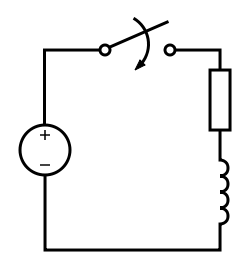Electronics/Inductors/Transient Analysis
The following is a description of the events that take place when a DC voltage is applied to an inductor. We need to consider that fact that the inductor has a parasitic resistance caused by the fact the wire it is made from is not superconducting. If we do not consider this, then we have a circuit with no way to dissipate energy - an ideal inductor is just a short circuit to DC once the magnetic field has been set up. So, we consider an ideal inductor in series with an ideal resistor as shown to the right.
- Before the switch is closed, there is no voltage or current across either the resistor or the inductor.
- When the switch is first closed, the current through the inductor is zero, because it cannot change instantaneously.
- This means that the inductor acts like an open circuit, so all the voltage is across the inductor.
- As the current ramps up from zero, the magnetic field builds in strength.
- The changing magnetic field creates a back emf which acts to oppose the current in the inductor. This back emf will not stop the current completely, but it will slow it down.
- Eventually, the current in the inductor reaches full strength (as governed by the resistor and the voltage by Ohm's Law).
- When this happens, the current is no longer changing, so the voltage across the inductor is zero. The magnetic field is still present, but it is static, so there is no back emf.
- All the voltage is now across the resistor, and the inductor acts as a short circuit.

The circuit will remain like this, with a certain current, all the voltage across the resistors and none over the inductor. There is a constant magnetic field in the inductor, and no back emf. However, when the switch is opened again,
- The current drops to zero very rapidly.
- The magnetic field collapses rapidly.
- The hanging magnetic field induces a back emf in the inductor. As the magnetic field changes so rapidly, the back emf is very large (infinite if the switch was perfect).
- This large voltage is across the switch.
- It is likely that a spark will jump the gap, possibly damaging the switch. If a transistor is used, it should be protected with diodes.
- After the back emf has settled, the circuit has no current and no voltage in it - we are where we started.
As you can see, inductors don't really add much to a DC circuit, except when energized and de-energized. However, in AC circuits, inductors can be used for many things.